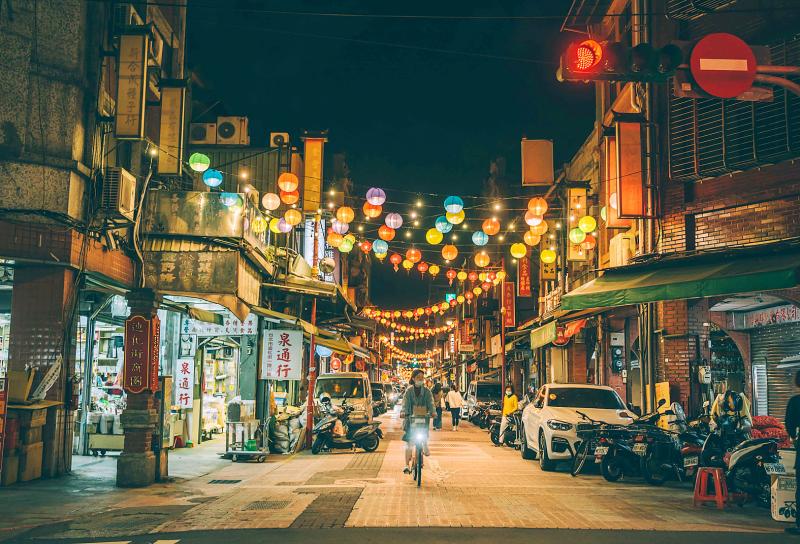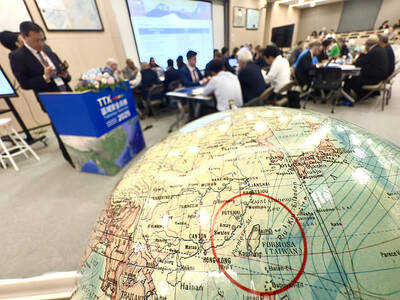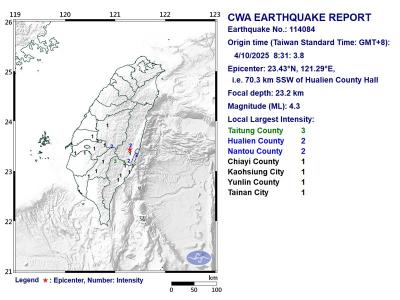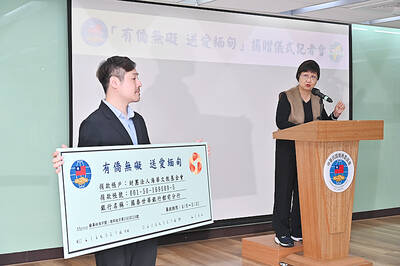The streams of shoppers, merchandise and signboards on the streets of Dadaocheng (大稻埕), one of the first international commercial districts in Taipei, easily elicit the hustle and bustle of what the area must have been like in the early 20th century.
Kuo Hsueh-hu (郭雪湖) captures such a scene in his 1930 work titled Festival on South Street (南街殷賑), which is one of the most celebrated pieces from Taiwan and the piece de resistance of the ongoing exhibition “Worldward: The Transformative Force of Arts in Taiwan’s New Cultural Movement” at the Taipei Fine Arts Museum (TFAM).
“Kuo vividly reproduced Dadaocheng’s prosperity and diversity,” said Sharleen Yu (余思穎), head of TFAM’s Exhibition Department and curator of the exhibition.

Photo courtesy of the Dihua Commercial District Development and Promotion Association
Dadaocheng was known as a place where progressive intellectuals gathered.
A painting of the area “is not only a reflection, but also an anticipation of Taiwan’s progress at the time,” she said.
Although Japan took control of Taiwan from Qing Dynasty China through the 1895 Treaty of Shimonoseki, social and cultural progress became bywords for Taiwanese intellectuals during Japanese rule.
In 1921, the Taiwan Cultural Association (TCA) was founded in Taipei by a group of Taiwanese intellectuals, who advocated for the participation of Taiwanese in the political process, from which they were largely excluded, and introduced the New Cultural Movement.
The movement gave rise to the first generation of Taiwanese artists to create art with strong Taiwanese characteristics and won art competitions.
“They proved their superior ability over their ruling-class counterparts, a way to fight for recognition and equality,” Yu said.
The TFAM exhibition, with more than 100 works by 37 artists from the 1920s to the 1940s, is dedicated to commemorating the centenary of the movement, which ushered in a golden age of Taiwanese art, the impact of which has reverberated throughout the century.
The exhibition is divided into five themes: Japanese painters and educators in Taiwan, art competitions and Taiwanese artists, modernity and local color, images of the modern woman and the rise of photography.
Kuo’s exuberant Festival on South Street, which is 1.88m long and hung in the center of the gallery, brought to life a busy and crowded scene in front of the Xia Hai City God Temple (霞海城隍廟) in Taipei during the Chung Yuan Festival (中元節).
The painting, which won an award at the second Taiwan Fine Arts Exhibition (Taiten) in 1928 and catapulted Kuo to fame, accurately depicted the diversity of Taiwanese culture, as exemplified in its colorful signboards written in Chinese and Japanese characters, and painted with Aboriginal patterns, as well as goods from Taiwan, China and Japan, which can be seen in the lower part.
What makes the painting so spellbinding is that it includes people from different walks of life, ensuring that everyone can easily identify with the work, Yu said.
It is also the first time in six years that the painting has been shown in public.
“The painting of gouache on a silk scroll is fragile and has to be kept at a certain temperature and humidity, which prevents it from being exhibited too often,” Yu said.
In the “Modernity and Local Color” section, one featured work is Chen Chih-chi’s (陳植棋) Chen-Jen Temple (真人廟), which won a special award at the fourth Taiten.
It portrays an ordinary and slightly dilapidated temple of the same name, overshadowing a white Western-style building next to it.
The painter specified the temple’s name for a reason: The painting was completed in 1930, the year that the Taiwanese People’s Party — nominally Taiwan’s first political party — relocated its headquarters next to the temple, which therefore became a symbol of Taiwanese, the museum said.
The party was banned in 1931.
Chen, who died at the age of 25, expressed his concerns and passion for politics by implicitly incorporating objects that contained hidden messages, as was commonly seen at a time of political oppression, Yu said.
The last section of the exhibition is dedicated to the image of modern women, in which Chen Chin’s (陳進) portrayal of women greets viewers with exquisite lines and warm colors, presenting a new image of women’s liberation.
Women’s liberation was one of the goals of the New Cultural movement.
“With more education for women and the abolition of foot binding, women’s body shapes and fashion changed from having more exercise and activities,” Yu said.
Following the changing times, Chen Chin, the first Taiwanese female artist to study in Japan, focused on elegant upper-class women in newly designed garments engaging in high-brow or outdoor recreational activities.
Her 1934 work, titled Out in the Fields (野邊), depicts a woman in a Taiwanese-style shirt and Japanese geta standing in a field with her children.
The woman’s complexion is serene and sophisticated, surrounded with blossoming flowers and emerald-colored bushes, all of which are painted with exquisite lines and soft colors, exuding a refreshing quality.
As the first Taiwanese female painter to be nominated at the Japanese Imperial Art Exhibition, the most prestigious art event in that country at the time, Chen once said: “I’m Taiwanese. I want to paint good works in a Taiwanese style. The important thing is to be better than the Japanese.”
It is unlikely that people in this period ever believed that a movement that called for political participation and equality, would eventually catalyze and accelerate the modernization of Taiwanese art.
These artists not only proved their worth as world-class artists, but also launched a belle epoque that still affects the art scene.
“These artists had a strong sense of mission,” Yu said. “Their works remind us how much they paved the way to search for and establish Taiwanese identity.”
“We are not only stunned by their skill, but also provoked to think about what they tried to leave us with 100 years ago, and carry it on into the future,” Yu said.
The exhibition runs until Nov. 28.

DEFENSE: The National Security Bureau promised to expand communication and intelligence cooperation with global partners and enhance its strategic analytical skills China has not only increased military exercises and “gray zone” tactics against Taiwan this year, but also continues to recruit military personnel for espionage, the National Security Bureau (NSB) said yesterday in a report to the Legislative Yuan. The bureau submitted the report ahead of NSB Director-General Tsai Ming-yen’s (蔡明彥) appearance before the Foreign and National Defense Committee today. Last year, the Chinese People’s Liberation Army (PLA) conducted “Joint Sword-2024A and B” military exercises targeting Taiwan and carried out 40 combat readiness patrols, the bureau said. In addition, Chinese military aircraft entered Taiwan’s airspace 3,070 times last year, up about

A magnitude 4.3 earthquake struck eastern Taiwan's Hualien County at 8:31am today, according to the Central Weather Administration (CWA). The epicenter of the temblor was located in Hualien County, about 70.3 kilometers south southwest of Hualien County Hall, at a depth of 23.2km, according to the administration. There were no immediate reports of damage resulting from the quake. The earthquake's intensity, which gauges the actual effect of a temblor, was highest in Taitung County, where it measured 3 on Taiwan's 7-tier intensity scale. The quake also measured an intensity of 2 in Hualien and Nantou counties, the CWA said.

The Overseas Community Affairs Council (OCAC) yesterday announced a fundraising campaign to support survivors of the magnitude 7.7 earthquake that struck Myanmar on March 28, with two prayer events scheduled in Taipei and Taichung later this week. “While initial rescue operations have concluded [in Myanmar], many survivors are now facing increasingly difficult living conditions,” OCAC Minister Hsu Chia-ching (徐佳青) told a news conference in Taipei. The fundraising campaign, which runs through May 31, is focused on supporting the reconstruction of damaged overseas compatriot schools, assisting students from Myanmar in Taiwan, and providing essential items, such as drinking water, food and medical supplies,

Taiwan is stepping up plans to create self-sufficient supply chains for combat drones and increase foreign orders from the US to counter China’s numerical superiority, a defense official said on Saturday. Commenting on condition of anonymity, the official said the nation’s armed forces are in agreement with US Admiral Samuel Paparo’s assessment that Taiwan’s military must be prepared to turn the nation’s waters into a “hellscape” for the Chinese People’s Liberation Army (PLA). Paparo, the commander of the US Indo-Pacific Command, reiterated the concept during a Congressional hearing in Washington on Wednesday. He first coined the term in a security conference last